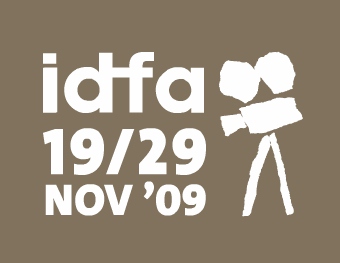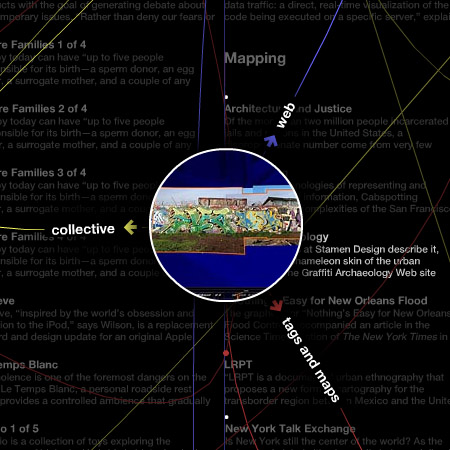Project INDIGO
May 15, 2023 on 7:06 am | In events and press, global news, related links | Comments Off on Project INDIGOBack in 2002, when Graffiti Archaeology was still just an idea and a shoebox full of photos, I didn’t know how the project would take shape. I was intent on capturing time, and change, and the work on the walls, but beyond that, anything was possible.
We considered building it in 3D: image-based modeling research had just started appearing in SIGGRAPH papers a few years before, so it seemed plausible. I imagined flying around in virtual tunnels mapped with photographed textures, and feeling like you were really there. But the research techniques were still experimental, and 3D on the web wasn’t really a thing yet either, so there was no easy way to share it with the world. So we set aside that fantasy, and opted for the 2D approach you see on the site, with a workflow based on production-ready tools like Photoshop and Flash.
A lot has changed since then. And last week I learned that a team in Vienna has picked up that dream and is running with it: Project INDIGO.
Their region of interest is a three-kilometer stretch of the Donaukanal, a branch of the Danube river that winds through the oldest part of Vienna and has been a graf magnet for decades. And these folks are serious. They’re methodical, and thorough, and their goal is nothing less than complete coverage, because then it can be used for science! But they’re also serious about ethics, so they’re trying to approach it in a way that respects writers and graffiti culture.

In 2022 they held a symposium that brought together graffiti writers, archaeologists, and other academics to discuss the project. I’m still poring over the proceedings— there’s a lot in there– but I quite like what I’ve read so far.
They’re holding a second symposium next month. Wish I could be there in person!
Subscription to Mischief
May 12, 2023 on 8:05 pm | In events and press, local news, stories and history | Comments Off on Subscription to MischiefLast weekend I got to attend the opening reception of a fantastic new exhibition put up by San Francisco’s Letterform Archive: Subscription to Mischief features a beautifully curated collection of photos, correspondence, and other ephemera from the dawn of graffiti zines in the 1990’s. It’s an amazing window into the pre-internet days when zines like Skills, 12 Oz Prophet, and Can Control were the only way writers from around the world could learn about each other’s work. The exhibition runs until November 2023. If you’re in the Bay Area, don’t miss it!




5 Pointz gets buffed
November 19, 2013 on 6:51 pm | In events and press, global news | Comments Off on 5 Pointz gets buffedThe slowly-unfolding tragedy in Queens just took a sudden turn for the worse. In a move worthy of a fantasy villain, the owner of the building known as 5 Pointz has ordered decades of artwork buffed overnight. Read more about it in the New York Times or the Guardian.
why Graffiti Archaeology doesn’t have maps
December 5, 2011 on 8:08 am | In events and press | Comments Off on why Graffiti Archaeology doesn’t have mapsA student in the New School’s Urban Media Archaeology class has written up an interesting critique of Graffiti Archaeology. It amazes me sometimes that our little project, now a decade old, still holds enough interest to merit this type of critique.
The critique calls out several contextual features that are missing from the project. Some of these are missing simply due to our lack of time to implement them. For example, labeling each writer’s work with their street name is standard practice among graffiti photographers, and I always do it when I post photos on Flickr. But implementing a system of artist-name tags would mean adding a host of interface features to make the system truly functional: a way of authoring, displaying and interacting with highlightable sub-regions of each layer, plus features to access the index of tags by artist name, search, etc… the list goes on! It’s been on my to-do list for years, but the implementation is just a bit beyond my present skill set. So yes, it’s a valid critique. And if you have the technical chops to help me make it happen, I’d love to hear from you!
But let’s talk about the lack of maps. This is not “missing” in the sense that it should be there but we haven’t gotten around to it. It is explicitly absent from the project at a conceptual level. It’s not a bug, it’s a feature. I touch on this briefly in our FAQ page, but my answer is not much of an explanation. A full explanation would mean a long discussion about graffiti abatement and enforcement, but the short answer is: I won’t tell you because that information is private.
Some of the walls we cover on this site are “legal” or “permission” walls. Others are not. My experience has been that the unauthorized walls are consistently the most interesting to study. On those walls, there are no authorities or gatekeepers. The only force that drives change on those walls is the force of graffiti culture itself. It is on those walls that the “why” questions are most fascinating. However, those walls only persist as long-running graffiti spots because their locations are a closely kept secret, known only among those who paint there and the people they trust.
When a location like that gets publicized, it’s called “blowing up the spot”. The metaphor of destruction is fairly accurate. Blowing up a spot threatens its integrity in various ways: it attracts toys (writers of little skill). Too many toys will drag the quality of the wall down, and discourage the really skilled artists from painting there. Graffiti abatement crews can descend on the spot and whitewash away years of history. Land owners can put up fences, local politicians can try to show they’re “tough on crime” by cracking down. But even tourists and photographers can cause trouble: too many people walking through an otherwise abandoned area can attract attention from police, posing a real physical danger to the people who paint there. Any combination of these things can permanently damage the unique character of a secret spot.
Urban Media Archaeology’s critique concludes with a description of an “ideal world” in which Graffiti Archaeology’s historical layering is merged with the crowdsourced geography of projects like OpenStreetMap and Walking Papers. I love both of those projects, but merging them with this one is a very bad idea. It would mean, essentially, the end of all secret spots. To me, this would be an intolerable outcome. It seems to be trendy these days to assume that sharing everything with everyone all the time is always a good thing. The “end of privacy” is often portrayed as inevitable, or even in the past. Facebook has certainly made a lot of money off of this naive view. I disagree. Maybe I’m old fashioned, but I still believe in privacy. And if I catch you putting secret spots on your Walking Papers, we’ll have to settle our beef the old fashioned way too.
Graffiti Archaeology at IDFA / Doc Lab
November 20, 2009 on 10:29 am | In events and press | Comments Off on Graffiti Archaeology at IDFA / Doc LabThe International Documentary Film Festival of Amsterdam has selected Graffiti Archaeology to be part of their Doc Lab program for 2009. More about Doc Lab:
IDFA’s Doc Lab investigates the relationship between documentary filmmaking and new media. The program is open to all media that can be used to tell a documentary story. During the festival, Doc Lab presents films, web documentaries, and installations that innovate the documentary genre. Projects are showcased in the Doc Lab Media Lounge and in cinemas during a number of special Live Screenings and events. The theme this year is Live Stories, and the principal guest is Ira Glass.
So, if you’re in Amsterdam this week, stop by the festival and check it out!
Graffiti Archaeology on Systm
September 1, 2008 on 10:02 pm | In events and press | Comments Off on Graffiti Archaeology on SystmLast week I had the pleasure of stopping by the studio of a local web-TV station to do an interview for Systm, the “Do It Yourself show for the common geek”. It was great fun, and the long format (30 minutes or so) made it easy to get into a bit more detail about the project. (Maybe too much detail… you tell me.) I also did a little demo of our photo-stitching process. So if you’ve been wondering about the nuts and bolts of how all this gets done, now’s your chance to find out! (You can watch the embedded video above, or visit Systm’s site to download it in high-def goodness.)
Graffiti Archaeology in Architect Magazine
March 30, 2008 on 12:46 pm | In events and press | Comments Off on Graffiti Archaeology in Architect Magazine
Architect Magazine runs a monthly column called “Screen Grab” that covers websites of interest to their readers. The March 2008 column is about Graffiti Archaeology. It’s a very short read, but it was a fun interview to do, because I got to try to think about the project from an architectural perspective for a change. One minor correction—this quote was taken out of context:
Since its launch in 2002, Curtis says, the site has helped make the urban art form “a more unified global cultural phenomenon” by offering an interactive database for visitors to peruse.
I wasn’t talking about Graffiti Archaeology there, but about graffiti websites in general! Grafarc.org was not the first such site, and it won’t be the last. If anyone should get credit for making graf a more unified global phenomenon, it should be Art Crimes.
Design and the Elastic Mind
February 24, 2008 on 11:08 pm | In events and press | Comments Off on Design and the Elastic MindI’m very proud to announce that Graffiti Archaeology has been included in the online catalogue for the Museum of Modern Art’s new exhibit, Design and the Elastic Mind. From the catalogue:
Over the past twenty-five years, people have weathered dramatic changes in their experience of time, space, matter, and identity. Individuals cope daily with a multitude of changes in scale and pace—working across several time zones, traveling with relative ease between satellite maps and nanoscale images, and being inundated with information. Adaptability is an ancestral distinction of intelligence, but today’s instant variations in rhythm call for something stronger: elasticity, the product of adaptability plus acceleration. Design and the Elastic Mind explores the reciprocal relationship between science and design in the contemporary world by bringing together design objects and concepts that marry the most advanced scientific research with attentive consideration of human limitations, habits, and aspirations. The exhibition highlights designers’ ability to grasp momentous changes in technology, science, and history—changes that demand or reflect major adjustments in human behavior—and translate them into objects that people can actually understand and use. This Web site presents over three hundred of these works, including fifty projects that are not featured in the gallery exhibition.
The collection is packed with beautiful, thought-provoking work by some really notable artists and designers, and it’s quite an honor to be included. Major props to Eric, Mike, Tom and the gang at Stamen, who also have several other pieces in the exhibit, including the always mesmerizing Cabspotting. If you’re in New York, be sure to stop by the MoMA to see the live installation!
Wilkommen, Bemvindo, Welkom…
October 17, 2007 on 9:56 pm | In events and press | Comments Off on Wilkommen, Bemvindo, Welkom…In addition to the popular blogs in English, lately I’ve been seeing a lot of links in to this site from foreign-language sites. It’s great to see how people from different cultures respond to the project. Here’s a quick roundup of recent international trackbacks:
Dutch: fontanel.nl thenielsch.web-log.nl flabber.nl
French: uqam.ca canalblog.com 2m3.net gayattitude.com pigtailbou liminarie.fr ecrans.fr fandart disobedience.be fluctuat.net insiturb1 uqam.ca netocean.free.fr
German: bluesbrothers sauglattismus blackbook.de kraftfuttermischwerk.de
Italian: lnx.zigolo.net visionet-art ilcannocchiale.it pimpmytrain.com
Japanese: parks12 designwork-s.com coliss.com bangchoo
Latvian: xlt.lv
Romanian: teoblog.com
Portuguese: agenciaging.com.br followwe e-ventos-tecnologicos perdidonaweb
Russian: visualstyle.ru
Spanish: webonauta inicios.es cuartoderecha revistasebo psicoexcesos.com bullmanu.com
Swedish: iman.se
I’ll keep this updated as new links come up.
Graffiti Archaeology got Dugg…
October 11, 2007 on 5:38 pm | In events and press | Comments Off on Graffiti Archaeology got Dugg……and the Digg Effect slammed our server so hard, I couldn’t even log in to edit this blog. Whoops! Sorry folks! One of these days, we’ll get one of those shiny new cold-fusion-powered servers with infinite free bandwidth.
Entries and comments feeds.
Valid XHTML and CSS. ^Top^
55 queries. 0.090 seconds.
Powered by WordPress with theme based on jd-nebula design by John Doe.



